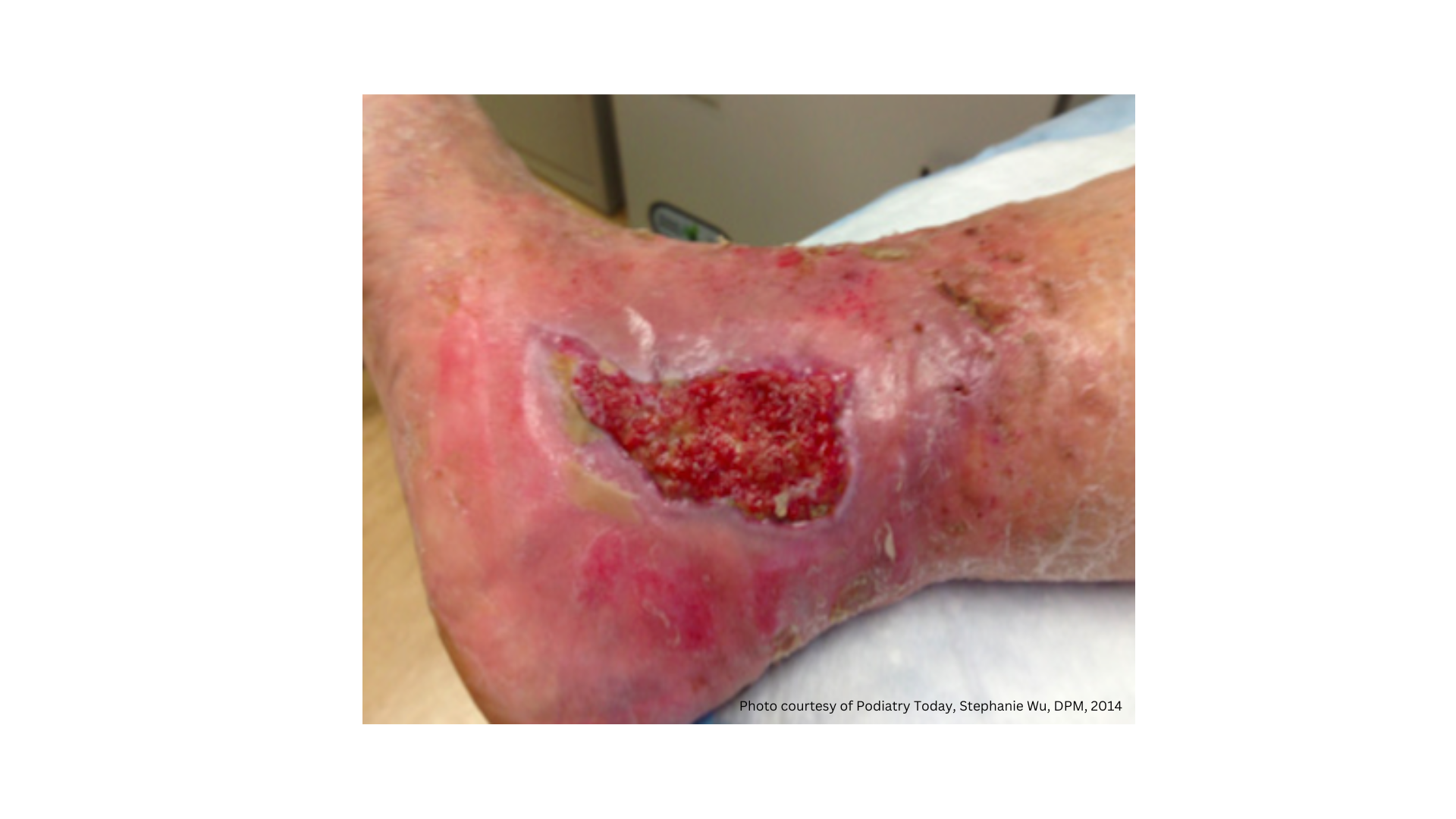Diabetic Foot Ulcers: Do You Know Best Practices?
March 17, 2023
Introduction
The impact of diabetic foot wounds is extensive. Diabetic foot ulcers (DFUs) are a major concern among those with diabetes. Research estimates that 25% of adults with diabetes may suffer a DFU sometime in their lifetime, with 20% of those requiring amputation.1 It is also estimated that DFUs cost around $1.4 billion for inpatient care alone.1
How to Classify Diabetic Foot Ulcers
Since several factors (neuropathy, PAD, foot deformities, etc) can contribute to DFU development, wound care professionals should use classification systems to assess the best plan of care.2There are a few classification systems for DFUs, including the following3:
- Meggitt-Wagner
- University of Texas
- Infectious Disease Society of America (IDSA)
- Perfusion, extent, depth, ischemia, and sensation (PEDIS)
- SINBAD
- Wound, Ischemia and foot Infection (WIfI) classification
The first and most commonly used system is the Meggitt-Wagner classification system.3 This system identifies 6 grades, with 0 indicating no open wound, 1 indicating a superficial wound, 2 indicating a deep wound that extends to the tendon or joint, 3 indicating a deep wound with either abscess, osteomyelitis, or sepsis of the joint, 4 indicating a wound with local gangrene to either the forefoot or heel, and lastly, 5 which is gangrene of the entire foot. As with many of the listed classification systems, the Meggitt-Wagner system has its limitations; for instance, infection is identified only when osteomyelitis is present.3 There is no consensus on which classification system is the most effective, and research is ongoing.2,4 After classification, wound care professionals should analyze risk factors that may stall healing or signify reoccurrence.2
How to Prevent DFUs
Clinicians should instruct patients with diabetes on proper foot care as well as methods to prevent DFUs. Good skin care is paramount. Wound care professionals should teach the patient with diabetes or their caregiver to inspect their feet daily, including the soles of the feet as well as in between the toes, where moisture can accumulate and cause skin breakdown. The shoes should also be inspected daily, as many patients with diabetes have neuropathy and cannot detect issues with their shoes or even items in their shoes. The feet should be washed and dried daily, taking special care to dry between the toes to prevent moisture and subsequent skin breakdown. These patients should always wear footwear inside as well as outside. Instruct the patient that toenail care may be best in the hands of a medical professional, depending on risk factors, and not to cut anything off their feet, such as dry, scaly skin. Glycemic control is a key factor in preventing and healing of DFUs.3 The patient should be instructed to have at least an annual diabetic foot exam by a health care professional.
Strategies for Healing DFUs
The gold standard for DFU treatment is offloading.5Clinicians can best accomplish offloading through the following methods, depending on factors such as anatomic location and ulcer size, including:
- Total contact cast
- Removable walking boots
- Offloading shoes
- Ambulatory devices (ie, knee walkers)
Wound care professionals should treat mild, moderate, and severe infections with various routes of antibiotic therapy based on patient history and clinical findings.6 Infections like cellulitis may be treated in the outpatient setting unless they become severe, in which case the patient should be hospitalized for IV antibiotic therapy.6 Many DFUs will need debridement prior to topical wound treatment application. Clinicians can usually accomplish this by conservative sharp debridement. For more severe needs, surgical debridement may be required. Other debridement methods may include autolytic, enzymatic, maggot, and hydrotherapy. Vascular assessment is also an essential piece of the wound healing puzzle for DFUs.3 There are a variety of non-invasive methods available to wound care professionals to assess vascular insufficiency, such as pulse palpation, Ankle-brachial index (ABI), Doppler ultrasound, and others.3 As stated prior, glycemic control is essential for proper wound healing. Once a wound is healed, the patient will likely benefit from evaluation for qualification for diabetic shoes or custom orthotics. At the very least, discussing proper footwear with the patient is vital to prevent further issues and reinjury. Studies have indicated that a multidisciplinary team approach provides the most favorable treatment option and reduces the incidence of recurrence as well.1
Duration
Many patients with any wound ask: "How long until this wound is healed?" Healing times can vary among patients, and it is best not to specify a set period for total healing. Some wounds heal quickly within a few weeks, some take months, and some never heal. The previously stated factors play into healing time, especially offloading. Adherence to all aspects of the DFU’s care and close monitoring by a foot care/wound care specialist will accelerate healing time in most patients. Advise the patient that unless the mechanism that caused the wound is corrected, the wound can recur. Wound care professionals should ensure that the patient has a referral to receive quality orthotics and shoes.
Conclusion
A recent meta-analysis of 34 studies from 2011- 2022 found the mortality rate for DFUs to be approximately 50%, with death occurring 5 years after initial DFU development. The researchers found vascular disease and infection as the 2 highest risk factors for mortality.7 This meta-analysis illustrates the importance of best practices for DFU prevention and management. Ultimately, wound care professionals should employ prevention practices, classification, management strategies (especially for infection and vascular issues), a multidisciplinary team, and follow-ups to best help patients with these wounds.
References
- Hicks CW, Canner JK, Mathioudakis N, Lippincott C, Sherman RL, Abularrage CJ. Incidence and Risk Factors Associated With Ulcer Recurrence Among Patients With Diabetic Foot Ulcers Treated in a Multidisciplinary Setting. J Surg Res. 2020; 246: 243-250, https://doi.org/10.1016/j.jss.2019.09.025. Accessed January 20, 2023 from https://www.sciencedirect.com/science/article/abs/pii/S0022480419306596.
- Wang X, Yuan C, Xu B, Yu Z. Diabetic foot ulcers: Classification, risk factors and management. World J Diabetes. December 15, 2022; 13(12): 1049-1065. doi: 10.4239/wjd.v13.i12.1049
- Akkus G, Sert M. Diabetic foot ulcers: A devastating complication of diabetes mellitus continues non-stop in spite of new medical treatment modalities. World J Diabetes. 2022;13(12):1106-1121. doi:10.4239/wjd.v13.i12.1106. Accessed January 24, 2023 from https://pubmed.ncbi.nlm.nih.gov/36578865/.
- Alahakoon C, Fernando M, Golledge J, et al. Repeatability, Completion Time, and Predictive Ability of Four Diabetes-Related Foot Ulcer Classification Systems. J diabetes Sci Technol. January 15, 2021; 17(1). https://doi.org/10.1177/1932296820986548
- Jarl G, Netten JJ, Lazzarini PA, Crews RT, Najafi B, Mueller MJ. Should weight-bearing activity be reduced during healing of plantar diabetic foot ulcers, even when using appropriate offloading devices? Diabetes Res Clin Pract. 2021; (175) https://doi.org/10.1016/j.diabres.2021.108733. Accessed January 20, 2023 from https://www.sciencedirect.com/science/article/pii/S0168822721000863.
- Lipsky BA, Senneville E, Abbas ZG, et al. Guidelines on the diagnosis and treatment of foot infection in persons with diabetes (IWGDF 2019 update). Diabetes Metab Res Rev. 2020; 36(S1):e3289. https://doi.org/10.1002/dmrr.3280
- Chen L, Sun S, Gao Y, Ran X. Global mortality of diabetic foot ulcer: A systematic review and meta-analysis of observational studies. Diabetes Obes Metab. August 20, 2022; 25(1):36-45. https://doi.org/10.1111/dom.14840
About the Author
Cathy Harmon, DNP, MSN, FNP-BC, CWON, CFCN is a Nurse Practitioner at the VA Medical Center in Lake City, Florida. She is the Wound Care Provider in the Out-Patient Clinic serving the Veteran Population of North Florida and South Georgia. Cathy is certified in wound, ostomy and foot care. In addition to her wound care experience, she also has experience in acute care, pediatrics, home health, long-term care and has served as a Professor of Nursing. Cathy’s passion for wound care began while she was working in the long-term care setting as an RN. She serves the veteran population as a memorial to her dad, a combat wounded WWII Veteran.
The views and opinions expressed in this content are solely those of the contributor, and do not represent the views of WoundSource, HMP Global, its affiliates, or subsidiary companies.











